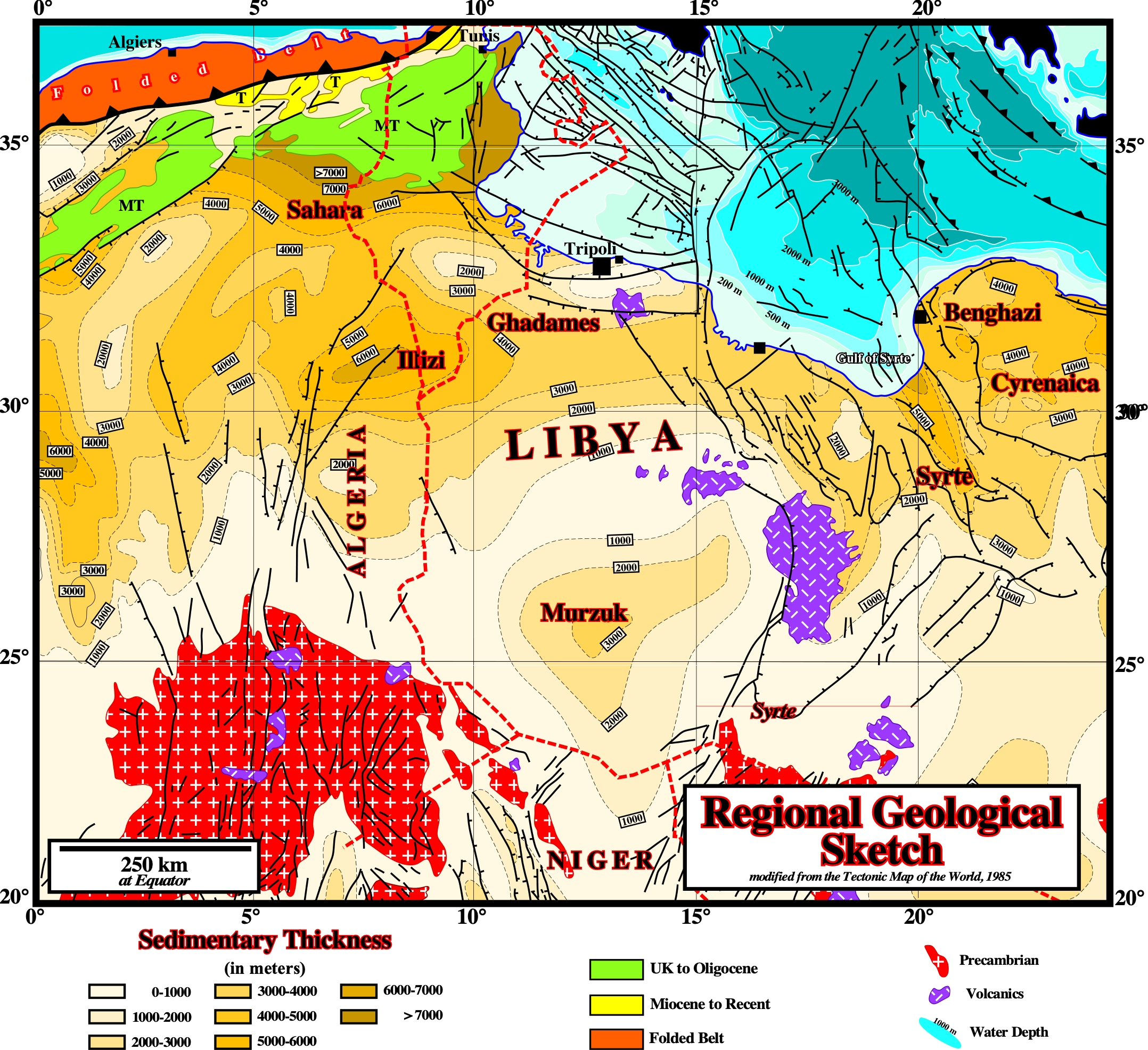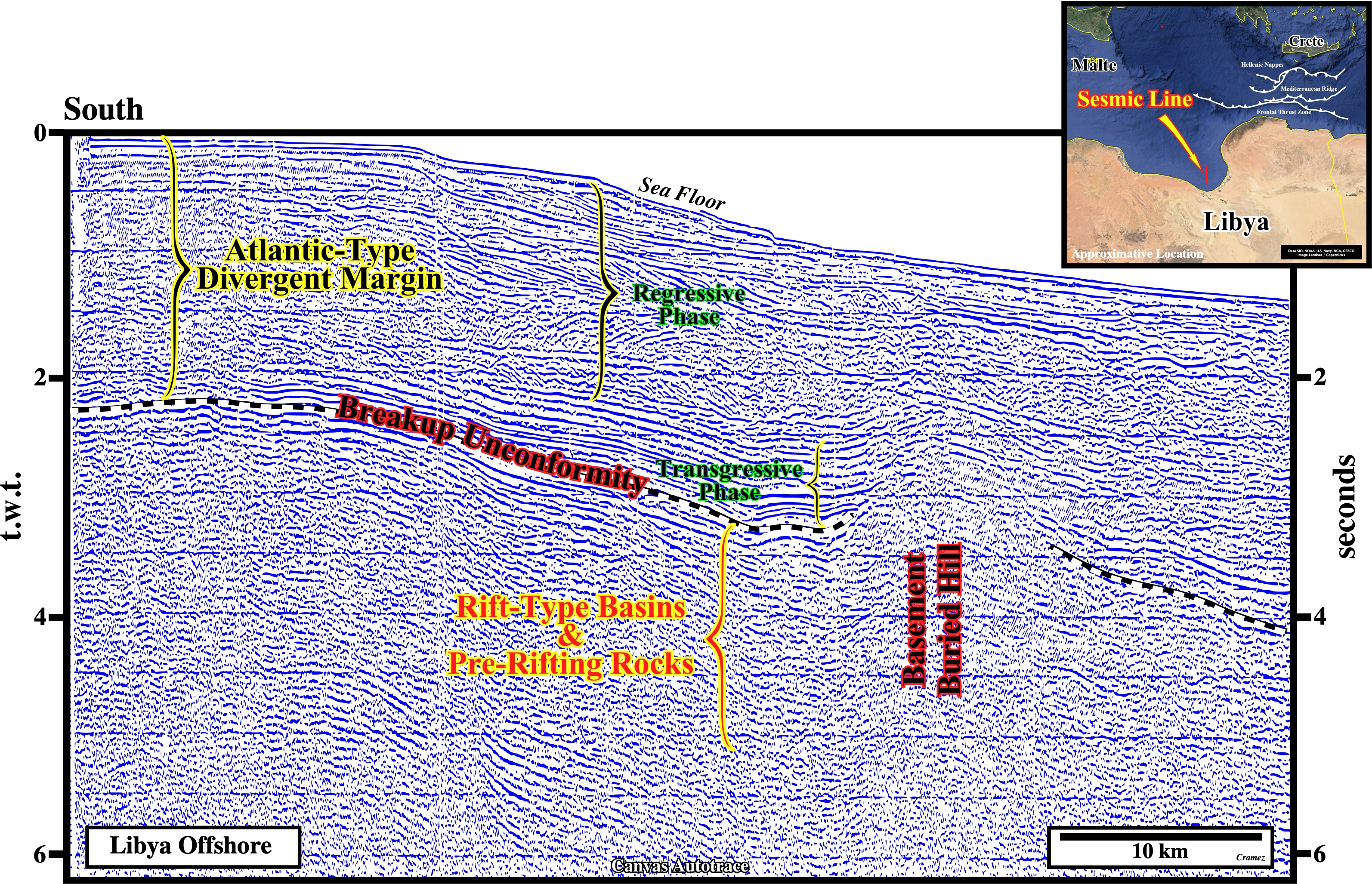.jpg)
.jpg)
Libya Offshore
Gulf of Syrte

On this regional geological map we can see the main geological features characterizing the Syrte embayment (onshore) and the Marmarica / Djefara geographic basin (onshore). The Syrte embayment or Syrte geographic basin, is the youngest of the Libyan geographic basins (Murzuk, Ghadames, Al Kufra and Cyrenaica). It has the largest petroleum reserves in Libya and is ranked 13th among the world's petroleum sedimentary basins. Geologically speaking, certain geoscientist consider that the area was a permanent high from the Middle Paleozoic until the Early Mesozoic and they attribute its origin the collapse of the Syrte Arch during latest Jurassic to Early Cretaceous times. In the Bally's basin classification it corresponds to an Atlantic-type divergent margin. The Marmarica / Djefara geographic basin covers almost Libyan offshore, between Tunisia/Malta/Ragusa platform and Cyrenaica geographic basin. The Libya offshore seismic lines suggest two phase of rifting. The half-graben and graben of the first phase were filled, mainly, by non-marine Jurassic– Early Cretaceous sediments, in which organic rich lacustrine sediments can form a significant generating petroleum subsystem. The second phase, which is less evident than the first one, since there is a change in the orientation of the σ2 of the extensional tectonic tectonic responsible of the lengthening, occurred during the Mid-Late Cretaceous, occurred during the Late Cretaceous. During this phase there are development of troughs and platforms. A marine ingression, progressively filled the lower areas with clastic sediments, which are fossilized by evaporites and and shallow-marine carbonates. The Atlantic-type margin seems to be initiated by the Maastrichtian marine ingression, since marine sediments covered not only the infilled troughs, but the rifted platforms as well (rift-type basins). At the end of the Miocene, during the Messinian a thick salt interval was deposited following a drying-up of the Mediterranean Sea between 5.96 and 5.33 Ma. The dessication of the Mediterranean Sea ended with the reopening of the Strait of Gibraltar (Zanclean marine ingression). It is interesting to notice that only the inflow of Atlantic water maintains the present Mediterranean level. In fact, without the Atlantic water's inflow, with a rate of net evaporative loss of ± 3,3 km 3/y, the Mediterranean Sea, with its 3.7 Mkm3 of water, would dry up ± 1000 years. However, this geological events can, easily, be recognized on autotraces of modern seismic lines, using hypothetical deductive interpretation approaches. On the majority of the old unmigrated seismic lines they cannot be recognized. However, in certain lines or autotraces, knowing what we are looking for (Theory precedes Observation) particular stratigraphic cycles can be recognized as illustrated below.

Knowing what you ate looking for on this Canvas autotrace of a old seismic line of Libya offshore (see Page 46A), i.e., knowing the geological context of the area where the seismic line was shot, in a first step of a tentative interpretation, it is easy to recognize: (i) An high of the basement (buried hill), i.e., a less subsiding area during the rifting, probably, located between two significant rift-type basins ; (ii) The Middle-Late Cretaceous breakup unconformity, which marks the end of the rifting and the onset of the Atlantic-type divergent margin ; (iii) The transgressive and regressive phases of the Atlantic-type divergent margin, induced by the second 1st order eustatic cycle of the Phanerozoic, are quite obvious ; (iv) The transgressive phase, characterized by a backstepping interval, was deposited during the Late Cretaceous marine ingression (absolute sea level rise), while the regressive phase, characterized by a progradational geometry, is associated with the absolute sea level fall created by the progressive shrinking of the oceanic basins.
Send E-mails to carlos.cramez@bluewin.ch with comments and suggestions to improve this atlas.
Copyright © 2001 CCramez
Last update:
2022